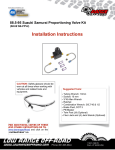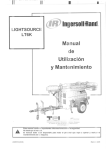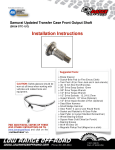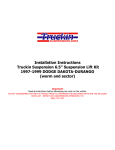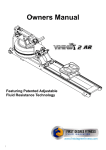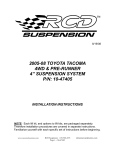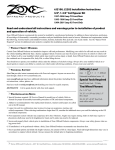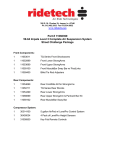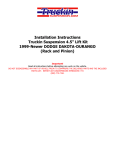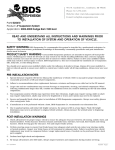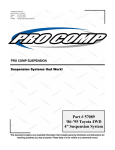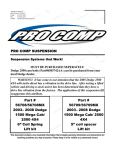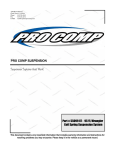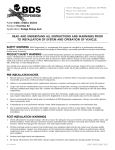Download Suzuki Sidekick/ Geo Tracker 2.5” LRTK Suspension Kit
Transcript
Suzuki Sidekick/ Geo Tracker 2.5” LRTK Suspension Kit 525 E. 1860 S. Provo, UT 84606 [email protected] lowrangeoffroad.com Please Note: Rock crawling and off-road driving are inherently dangerous activities. Some modifications will adversely affect the on-road handling characteristics of your vehicle. All products sold by Low Range Off-Road, LC are sold with intention for off road use only. Any other use or application is the responsibility of the purchaser and/or user. Some modifications and installation of certain aftermarket parts may under certain circumstances void your original dealer warranty. Modification of your vehicle may create dangerous conditions which could cause serious bodily injury or death. Buyers and users of these products hereby expressly assume all risks associated with any such modifications and use. Low Range also strongly recommends that all products be installed by trained professionals only. Tools Needed: • Metric wrenches/sockets • Floor jack • 2- jack stands Optional: • • • • • • • Factory Service Manual (FSM) for torque specifications and background information. Torque Wrench Angle Grinder Die Grinder with Carbide Bit, 3/8" cylindrical Rubber mallet Snap ring pliers Large needle-nosed pliers Parts Included: • • • • • • • • 2- Front Old Man Emu Coils 2- Rear Old Man Emu Coils 4- 1" Coil Spacers 2- Front Old Man Emu Long Travel Struts 2- Rear DT3000 Series Long Travel Shocks 1- Front Camber Alignment Bolt Set 1- Rear Upper Control Arm Bracket 4- Bolts/Nuts for Upper Control Arm Bracket Optional: • 2- Rear Old Man Emu Shocks (extra cost) • 15" of 5/16" fuel line hose (not included) • Locking nuts or fresh locking washers for shock/strut mounts (not included) Page 1 Notes on Part Selection: OME Coil springs offer a great ride quality. The springs are tailored based on the amount of weight (short wheel base vs. long wheel base, adding bumpers and winches, etc.) that you are going to run. Make sure and talk to us to get the right springs for your application. We like to use the DT3000 shocks in the rear because they offer the most travel and are affordable. If you are going to drive mainly on-road and prefer the smoothest ride possible and especially if you have a light 2-door, then you may want to use the OME N32 rear shocks instead. The OME rears offer about 2" of additional extension while the DT3000's offer over 3" of additional travel. Step 0: Before you start Read all instructions before starting. Take the time to measure your stock height before any adjustments. You can measure the height of the fender over the ground and the height of the front lower cross member from the ground. However, both of these are affected by tire height (affected by inflation as well) so if you change your tires at the same time it will be harder to keep track. As an alternative, you can measure from the bottom of the hubs to the top of the fenders and that way track just your suspension adjustments Step 1: Take a "before" picture. Step 2: Unpack your parts and make sure you have everything Page 2 Step 3: Jack up the rear Crack the lug nuts loose, and then use the rear differential to lift the rear of the vehicle high. Because you will be installing items that let your rear suspension drop farther down, make sure you jack it up high enough. Chock the front wheels, use two jack stands on the frame just in front of the rear tires. Step 4: Remove rear wheels Step 5: Disconnect lines and bottoms of shocks Use the jack under the rear differential to move the rear axle up and down as necessary. Disconnect the brackets for the emergency brake lines on each side. You may want to disconnect the breather line on the top of the rear differential. This can be too short for your new downward travel. If so, replace with a 15" section of 5/16" fuel line. With the axle supported (relieving pressure on the shocks), take out the bottom bolt for the shocks. Page 3 Step 6: Remove the shocks and springs On top of the rear axle there is an upper control arm that attaches by 4 bolts. Remove these bolts. Remove the top two nuts on each shocks and remove the shocks. Use the jack to lower the axle until the springs can be taken out by hand. Remove the upper rubber spring pad (needle-nosed pliers are helpful) and clean up the bump stops. Page 4 Step 7: Install the upper control arm spacer Install the spacer using the stock bolts as well as the provided bolts and nuts. The hollow shaft should be toward the rear of the vehicle. You may need to use the jack to lift the axle into a position where you can get all of the nuts on the bolts. Page 5 Step 8: Install rear coil spacers and springs Slide the coil spacers onto the rear bumpstops. These may be hard to slide into position. A small amount of grease/oil may help, or you may need to use a rubber mallet to get them into place. You can also soak the spacers in HOT water for a few minutes to loosen them up. The rear coils are the longer springs in your kit. Slide the springs up on to the bumpstop and onto the spring perch, aligning the spring with the detent in the perch. You may need to lower the rear axle. For the second spring you may even need to move the jack to the opposite side and jack that side up a bit, but you should be able to get the spring on by hand, or at worst with a large screw driver to get it over the hump. Be careful with springs as they can store and release a lot of energy. Step 9: Install rear shocks Use the included new hardware to mount the top of the shocks. For the DT3000s, you will also have to insert the included metal sleeve into the lower mount as well. Jack up the rear axle (in the center again) until the axle is even or higher than the bottom of the hanging shocks, then you can install the bolts. You may want to use a fresh locking washer or a nylon locking nut. If you use the optional OME rear shocks, you can use some washers as spacers to lower the shock in the upper mount, gaining about 1/2" of downward travel. Page 6 Step 9b: (Optional) Grind the lower shock mounts Before finishing your rear suspension installation, you should see if your shocks clear the lower shock mounts at full extension. With the shocks installed, lower the rear axle and watch to see if the mounts will contact the shock body. If they make contact and you plan on fully using your extension and don't want scratches or dents in your shock body, you should make adjustments now. You might be able to get enough clearance by some careful bending of the shock mount with large pliers. Or you can use an angle grinder (or similar) to remove the interfering portions of the mount. Use eye protection when grinding. Page 7 Step 10: Finish the rear suspension Reattach the breather hose on the rear differential if you haven't already. Reattach the emergency brake line brackets. Reinstall the wheels. Raise the vehicle off of the jack stands and remove them. Lower the vehicle and torque your lug nuts to spec. Page 8 Step 11: (Optional) Remove the front CV clips You can remove the clips on the front CV axles. The advantage is it allows the front axles to slide in relation to the spindles under full drop and not limit the suspension. The disadvantage is that when the axle slides, it opens the seal to the hub on the inside of the wheel allowing dirt and water into the spindle area. Step 12: Jack up the front Crack the front lug nuts loose. You can use the lower cross-member as a jack point for the front end. Be careful to have something like a 2x4 in between the jack and the cross-member so as to not dent it in. Put jack stands under the frame rails near the front. Jack the front up very high to facilitate the following steps. Step 13: Remove the wheels Step 14: Completely remove the sway bar The sway bar is connected to each A-arm by a 14mm nut. Remove these. Also remove the mounting bolts (a 17mm and a 12mm on each side). Lift the sway bar out of the A-arm holes and remove. This may seem unnecessary, but it is easy to do and make subsequent steps easier. Some people may elect to leave the sway bar off permanently, but it is good to re-install for road driving. Regardless, remember to replace the nut on the A-arm mounting point. Page 9 NOTE: You'll probably want to do many of the following steps for one side of the car before doing them on the other side of the car, unless you have 2 floor jacks handy. Step 15: Remove the brake line clips Remove the brake lines from the struts. You can use pliers, or a large flat screwdriver and a hammer to slide out the clip. Step 16: Remove old struts Use the jack and to put enough pressure on the A-arm to raise it about an inch. This removes pressure from the strut. Page 10 Each strut is mounted with 3 small bolts on top. On the driver's side, the air box will have to be removed to access the bolts (depending on year). Remove these bolts. Remove the two bolts holding the strut to the steering knuckle and remove the strut. Remove the top strut mount from the strut. Step 17: Install new struts Using the new lock nut, put the strut mount on your new struts. Install the top bolts but not the steering knuckle bolts at this time, letting the strut just hang in the wheel well. Re-install the airfilter box. Step 18: Remove the brake calipers It is important to not over-stretch the brake lines during this install. In order to not have to mess with spring compressors, the steering knuckle must be allowed to tilt outward and drop significantly. If the caliper is left installed, the brake line can be damaged. It is better (and ultimately quicker) to just remove the caliper by removing the two bolts on the back side. If you have ABS brakes you will also have to unclip the wheel speed sensor. Once removed, use a coat-hanger, strap, or bungee cord to hold the calipers out of the way and relieve stress on the brake line. You can hang them from the struts. Page 11 Step 19: Disconnect the CV joint In order to fully lower the A-arms, the CV joints must be disconnected. On the driver's side, there are three bolts to disconnect, 2 of which are shown in the following picture. Page 12 On the passenger side, with the A-arm supported fully by the jack beneath, pull on the CV axle mildly while turning it slowly. If this doesn't allow it to pop out, apply mild pressure with a large flat screwdriver between the axle and the differential. Step 20: Remove the old springs Lower the jack under the A-arm slowly (remember the springs can be under a lot of pressure). Once the A-arm is bottomed out, you should be able to just pull out the old springs. Remove the rubber spring seat from the top (needle-nosed plied may be helpful). Clean up the bump stops. Step 21: Install coil spacer and new springs Slide the coil spacer over the bump stop. Use grease/oil/hammer/hot water as necessary to seat it. Put the spring in place, aligning the end of the spring with the detent in the lower perch. Slowly jack up the A-arm, watching to make sure it remains seated and aligned. Page 13 On the passenger side, you will need to re-insert the CV joint in multiple steps as your raise the A-arm. On the driver's side, once sufficiently raised you'll need to reattach the CV axle with the 3 bolts. Page 14 Step 22: Reattach the strut Once the A-arm has risen sufficiently, replace the strut bolts. You can use the camber adjustment bolts in the top holes to help correct the camber. As the A-arm is not at its normal level, it can be a trial-and-error process to get it right. Or, since you should have your toe alignment adjusted anyway, you could just let the alignment shop handle it. Generally, since you are raising the vehicle by dropping the A-arms, you'll need to move the top of the steering knuckle closer to the frame (making the camber less positive). You will then end up with too much toe out as well. Step 22b: (Optional) Slot upper strut bolt holes Your kit includes camber correction bolts, but it is possible that these may not provide enough camber correction. In this case, you (or a shop) will need to slot the upper spindle bolt hole. You can use a die grinder with a cylindrical carbide burr (3/16" works). Widen the hole toward the body of the strut. Be careful to not widen the hole vertically so the bolt and nut will have solid material to grab on to. Push the steering knuckle into the strut. If the bolt hole will still let a bolt through when the steering knuckle is all the way back against the strut body, you should have enough adjustment room. Page 15 Step 23: Button it up Tighten all bolts according to the specifications in your FSM. Tighten your strut bolts. Reinstall the brake calipers and tighten. Reinstall your brake line clip and speed sensor if you have ABS. Reinstall the sway bar. Put the wheels on and drop the vehicle. Torque your lug nuts. Step 24: Get an alignment Step 25: Make sure and re-align/aim your headlights. Put your Low Range decals on, take a picture and make measurements for comparison. Enjoy your new clearance! Page 16
















